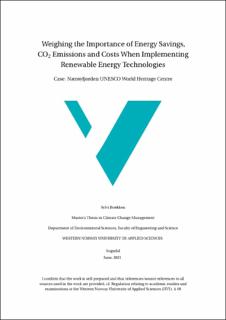| dc.contributor.author | Brækken, Sylvi | |
| dc.date.accessioned | 2021-10-22T08:35:12Z | |
| dc.date.available | 2021-10-22T08:35:12Z | |
| dc.date.issued | 2021 | |
| dc.identifier.uri | https://hdl.handle.net/11250/2824914 | |
| dc.description | Master’s Thesis in Climate Change Management
Department of Environmental Sciences, Faculty of Engineering and Science
2021 | en_US |
| dc.description.abstract | Buildings and construction of buildings account for around one third of the energy consumption in
the world. A large investment in energy efficiency can reduce the energy use of Norwegian buildings
by 39 TWh from 2020 to 2050. The energy saved through energy efficiency measures in buildings
can be used in other sectors, such as the industry and transport sectors. In 2017, the building and
construction sector contributed with 18% of Norwegian greenhouse gas emissions. It is important to
reduce greenhouse gas emissions and energy use of buildings to contribute towards the sustainable
development goals (SDGs) and a sustainable future.
This master’s thesis looks into different combinations of renewable energy technologies that can be
implemented in the renovation of Nærøyfjorden UNESCOWorld Heritage Centre. The thesis is part of
a larger project that includes three master’s theses, all looking at theWorld Heritage Centre but with
different focus areas. The purpose of this thesis is to discuss how energy savings, CO2 emissions and
costs can be weighed against each other and to recommend a combination of energy technologies for
theWorld Heritage Centre.
The evaluated combinations include one or several of the following energy technologies: water-towater
heat pump, air-to-water heat pump, evacuated tube collectors, flat plate collectors, standard
solar panels and solar shingles. All combinations also include an electric boiler covering 10% of the
heating demand. Energy simulations were conducted using SIMIEN; life cycle assessments (LCAs)
were performed in One Click LCA, and costs were found through research and used in the net present
value (NPV) method.
Finally, the combination with a water-to-water heat pump, flat plate collectors and standard solar
panels was recommended. This combination resulted in the fourth highest energy savings and a slightly
negative NPV, which was seen as acceptable. The difference in emissions between the combinations
was minimal, and this was therefore not considered in the assessment.
Due to uncertainties regarding costs, the real profitability of the solutions could be different. Before
deciding on a final combination for the UNESCOWorld Heritage Centre, professional consulting and
inspection of the area and building are required. | en_US |
| dc.language.iso | eng | en_US |
| dc.publisher | Høgskulen på Vestlandet | en_US |
| dc.rights | Navngivelse 4.0 Internasjonal | * |
| dc.rights.uri | http://creativecommons.org/licenses/by/4.0/deed.no | * |
| dc.subject | renewable energy technologies | en_US |
| dc.subject | solar panels | en_US |
| dc.subject | solar thermal collectors | en_US |
| dc.subject | heat pumps | en_US |
| dc.subject | fjord | en_US |
| dc.subject | sustainable development goals (SDGs) | en_US |
| dc.subject | UNESCOWorld Heritage | en_US |
| dc.subject | renovation | en_US |
| dc.title | Weighing the Importance of Energy Savings, CO2 Emissions and Costs When Implementing Renewable Energy Technologies | en_US |
| dc.type | Master thesis | en_US |
| dc.description.localcode | GE4-304 | en_US |

